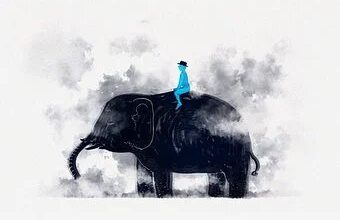
Ama Ata Aidoo’s The Girl Who Can and Other Stories (1997) is a short story collection centred on female empowerment. Here, she expresses her concern regarding the lack of education opportunities for women in Africa of her time. Being an education administrator, she believed in its liberating force to give a new identity to all women. As a woman born in post-independent Ghana, she embarked on a journey to fight for the rights of women to mirror their progress with the development of the new nation.
The story “The Girl Who Can” highlights the importance of a women-centric society by portraying a female tripartite household. She creates a young female athlete Adjoa who is also the narrator of the story. Her interactions with her mother and grandmother constitute generational conflicts in the backdrop of a male-dominated world of sports. Aidoo weaves a narrative which dwells on issues pertaining to gender roles, freedom, debate between tradition and modernity, and community.
The Girl Who Can | Summary
Adjoa, a seven year old girl introduces herself as an African child born in the village of Hasodzi which is a fairly fertile land compared to the rest of Africa. She naively interrogates the societal constraints a child, especially a girl experiences when uttering a word in public. Her mind is constantly engaged in issues and concerns too intelligible for a girl of her age which leads to the three generations in the story – Adjoa, Maami (mother) and Nana (grandmother) facing a conflict of opinions on a usual basis. The father is not in the picture but a sense that he is not a good man or possibly abandoned them shadows the plot. Nana is authoritative and holds a firm view about a woman’s role in society i.e. to be physically fit to rear healthy children. On the other hand, Maami (addressed as Kaya by Nana) often comes out as a speechless character who is incapable of raising her voice against her mother.
Adjoa is a complex mix of the two. She harbours questions about the workings of the society but opts to keep them safe in the treasure of her mind for two reasons- primarily to avoid causing distress to her grandmother and also to be at bay from becoming a butt of jokes. Adjoa’s thin legs trouble Nana for she stresses their incapability to hold a solid figure for a woman giving birth. Adjoa’s physicality couples with her social movements like going to school which Nana also looks down on. Her constant criticism about Adjoa occasionally faces Maami’s snippets of courage who attempts to argue in support of Adjoa.
However, a change of perceptions creeps in when Adjoa reveals her selection for a district race. Nana’s behaviour suddenly alters and she puts in efforts to wash her granddaughter’s uniform and iron it neatly. She accompanies Adjoa for the entire week of the race in new attires which she wears only for special occasions. When Adjoa bags the trophy, she shows it around the neighbourhood like a proud grandparent with tears of joy. The story culminates with a happy realisation for both Nana and Adjoa that legs serve more purposes to a woman than just giving birth. A woman’s identity should not restrict itself to being a mother and a wife. It should also predicate her achievements, in this case as an athlete.
The Girl Who Can | Analysis
Aidoo claims that for an African woman, the struggle begins with the right to be born as a girl child and passes through challenges such as having a whole body, going to school and lastly acquiring the right to be heard. By creating a women-centric narrative through the lens of a girl child, she proposes an unfiltered worldview to these situations in postcolonial Ghana. The narrator Adjoa often possesses questions about the conventional roles of a woman in her society. Though she hesitates to be upfront about them, she lets the readers have a peep inside her mind while she struggles to evaluate the appropriateness of time and issue. She is often silenced with laughs and strict remarks by her Nana. Adjoa’s silencing and Maami’s usual speechlessness hint at verbal censorship operating in the household like an authoritarian rule during the colonial era.
Colonialism is a reminder of pain and humiliation that Africans still fail to recover from completely. With all its negative implications aside, the one good thing it should be credited for is the establishment of schools and the promotion of education. The education of women is a key to uncovering their potential hidden under the heap of myth and tradition. For instance, Nana’s rebuttal of schools and their uselessness in a woman’s life becomes a subject of criticism. It is only after Adjoa’s win in the district race that she realises the opportunities a school knocks at the door of a woman. Maami expresses her regret for not having an access to education but she is delighted for her daughter. Women have to bear the burden of their gendered identity because their identity needs to align with the patriarchal stereotypes such as women’s bodies serving only sexual purposes and carrying children in their wombs. But Adjoa defies this reductive understanding by carving out an alternate life for herself right at an early age as an athlete.
To be an athlete in a world where sports witness domination of the other gender, Adjoa crosses the gender divide. Her legs which are condemned by Nana throughout the story as thin and long, become the reason for her win. Nana’s constant distress compels her to voice out an absurd logic- “if any woman decides to come into this world with all of her two legs, then she should select legs that have meat on them: with god calves. Because you are sure such legs would support solid hips. And a woman must have solid hips to be able to have children.” The aspect of one choosing to come into this world calls attention first. One can never choose to be born. It is fate and destiny that decides your family and physical well-being during birth. Secondly, comparing the body mass to meat objectifies a woman who is no more than a domestic animal destined to serve one by operating on utilitarian principles. Nana’s character in the early parts of the story becomes a representative of a woman oppressing another woman. Adjoa takes a humorous dig at her grandmother’s notion by desiring to look at the legs of the women in her village, who are mothers, a project she fails in due to their wrap-around skirts. For her, legs are legs and she isn’t quite sure what qualifies as meat.
Culture and communal togetherness also occupy an essential space in the construction of the narrative. Adjoa commences the story with “They say” as a reference to her knowledge about her birthplace passed down to her by her community. The instances where Nana shares Adjoa’s critical opinions about the world with the other women of the village and the concluding scenario of showing the trophy to everyone depict sharing of happiness with one’s community. Africa is famous for its various tribes and communities and the cultural unity they stick to. Even the author employs African English and dialogic writing to pen her story. The oral feature of the story resides in its multiple usages of the conjunction “and” that renders it a flow and continuity.
Thus, Aidoo portrays a character like Adjoa to emphasize the renowned saying “action speaks louder than words.” She proves the capability of her thin legs by winning the race and also providing satisfaction to her Nana who at last believes “thin legs can also be useful.” Sometimes, young children can also educate their elders and become a medium of change. They are pioneers for the future and thus education should be encouraged for a better and brighter tomorrow.
The Girl Who Can | Characters
ADJOA – She is a 7-year-old girl who is also the narrator of the story. Her view of her society differs from her elders and she questions certain ideologies running down for generations in her own innocent way.
As a runner and a winner at a district-level race organised by her school, she facilitates a change in the perception of her conventional grandmother who until then looks down on her for having thin legs. She is a bright child whose education becomes a medium to introduce an altered mindset in her matriarchal household.
MAAMI – Throughout the narrative, she occupies the least space due to her as a hesitant and speechless character. She loves her daughter Adjoa and supports her in her dreams of becoming an athlete. However, when it comes to protecting her from discouraging comments from her own mother Nana, she turns timid and lacks courage. She is a static character who undergoes no change.
NANA – The matriarch of the house, she is a strong and authoritative woman who cherishes to silence people around her in her own distinct style. She speaks with a great experience at hand and thus feels to be superior and the most knowledgeable in the house. Adjoa and Maami often stand in opposition to her views but she is a dynamic character who experiences a change after learning about Adjoa’s skills as a runner and her subsequent win. In the end, she does realise that a woman’s body has more to its existence than just giving birth to children.
The Girl Who Can | Themes
GENERATIONAL CONFLICT – Three generations operate in the story. Adjoa, the narrator is the youngest and Nana, the grandmother is the oldest. Adjoa has questions and doubts that she feels lack an appropriate expression – “there are things I can think in my head, but which, maybe, I do not have the proper language to speak the out with.” There is communication anxiety with her grandmother due to a differing set of beliefs. The grandmother holds a traditional worldview that sees a woman in the light of motherhood alone compared to Maami and Adjoa who wish to add more feathers to their cap. Nana’s conventionality can be linked to her lack of education and orthodox upbringing. However, Adjoa is born in a postcolonial era which is venturing toward modernity and thus it is evident for the two worlds to clash. But the clash results in a positive outcome surprisingly with a change of heart in Nana after realising the real capabilities of a woman.
RUNNING – Running symbolises freedom and with freedom comes the power of choice as the narrator possesses certain choices that her mother and grandmother didn’t have an access to. Adjoa not only runs to build an identity as an athlete but also to move away from the rigid strictures of her society. Thus she runs towards an optimistic and bright future by running away from a traditional and stereotypical past.
The Girl Who Can | Literary Techniques
CONTRAST – The narrator introduces the landscape of her village by juxtaposing its uniqueness with the rest of the continent. She states when the entire Africa experiences drought, the Hasodzi village remains fertile.
She also draws a contrast between her mother’s womb and the outside world as “the land of sweet, soft silence into the world of noise and comprehension” to highlight the chaotic and claustrophobic society she lives in.
SATIRE – Contemplating the issue of legs that follow her grandmother’s beloved ideals, Adjoa claims “In my eyes, all my friends have got legs that look like legs; but whether the legs have got meat on them to support the kind of hips that…that I don’t know.” She exposes the illogicality of differentiating between the different types of legs as their primary function is to enable a person to move and not support the hips solely to give birth.




its great n helpful ty!